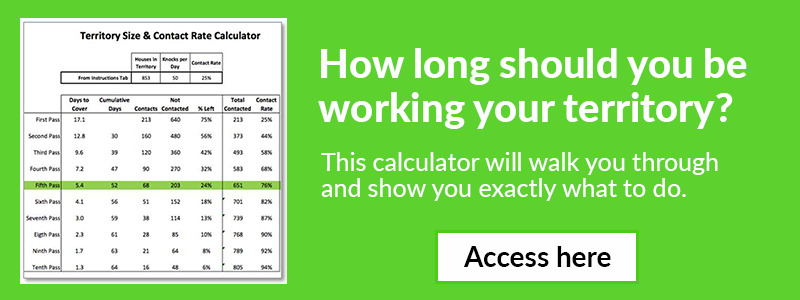Designing sales territories has never been more important for door to door and field sales teams. Unfortunately, designing sales territories is a process that the majority of sales managers rush through. This is a major issue for something that is guaranteed to have a considerable impact on each sales rep’s ability to achieve their quota.
HBR found that optimizing sales territory design can increase revenue by 2 to 7% without making a single change to the company’s overall resources or strategy. When done properly, there’s a good amount of leg-work that goes into sales territory design. But it’s a crucial part of setting your team up for success.
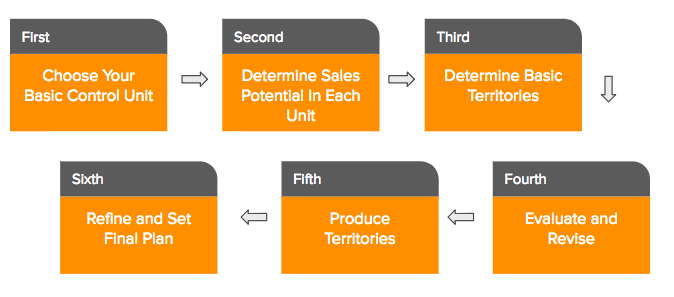
Sales territory design is often viewed as a tedious process by managers who lack a thorough understanding of the direct impact it can have on their team. Quite simply, this is one of the first steps you should take to ensure your team is working in territories with enough prospects who match your ideal customer profile.
With the amount of analytics available today, salespeople should rarely walk blindly into new territories. Lead generators, like Lead Machine, are a great way to identify key territories and potential customers based on the market demographics of your ideal customer.
6 Signs of Poor Sales Territory Design
Establishing a well thought out sales territory design will take a lot of effort in the beginning. But it’s imperative to invest the time, energy and resources. Not doing so will waste your sales peoples’ time and cost you money. Don’t risk losing out on closeable prospects because you didn’t take the time to plan.
- Well designed sales territories can increase sales productivity by as much as 10%-20% (Source)
- If sales territories are not adjusted periodically, sales organizations can encounter situations where growth is constrained in up to 20% – 30% of territories (Source)
- Research by the academics Andris A. Zoltners, PK Sinha, and Sally E. Lorimer showed that sales territory redesign can increase sales by as much as 7% —without altering strategy or budget.
# 1 | Salespeople targeting the wrong prospects
Understanding that your sales fortune is in the follow up shouldn’t be news to you. But have you ever looked into the accounts each sales rep is actively following up with compared to the ones they’re not?
There’s a lot more to the story than just making sure salespeople are re-engaging potential customers. Many organizations have reps who aren’t following up with quality leads, and others who are spending a good portion of their time chasing low-potential opportunities.
It goes without saying that this requires better data, and coaching.
On the other hand, many fail to consider the very real possibility that this is a sales territory design issue. The salespeople who don’t have the number of high quality prospects needed to stay busy on a daily basis are almost forced to over pursue the potential customers with a low probability of converting.
That’s clearly not an ideal situation. And what’s even worse is this can cause good accounts to be ignored. When sales territory design isn’t a priority, some salespeople are blessed with an abundance of quality leads to work while others are stuck chasing the chicken.
The sales rep with too many accounts to work often becomes too busy to put forth the required effort needed on every deal. These individuals also tend to make their quota solely by working the “easy” accounts due to the large number of leads in their funnel. They lose their drive and hunger.
The easiest and best solution for resolving this issue is to reexamine how you design sales territories. If you end up in the situation above, you could be forced to redistribute accounts from one sales rep to another, leading to a lot of complaining. This type of negativity casts a black cloud over the company culture you’ve worked so hard to build.
#2 | Sales reps are duplicating efforts
If your reps aren’t crystal clear on which accounts they’re responsible for and in what areas, they’ll end up working the same leads. This problem is two-fold:
- Your reps will get frustrated. Nobody wants to take the time to travel to a potential customer’s place, only to learn that a colleague was just there a few days ago and already planted seeds to make a sale.
- Your prospects will become annoyed. Leads don’t want sales reps to duplicate their efforts anymore than reps do. They have work to do and unnecessary conversations with outside sales teams are a distraction.
Frustrated sales reps and annoyed leads is exactly what you don’t want. Fortunately, proper sales territory management will solve this problem.
#3 | Territories not getting enough coverage
Another sign of poor sales territory planning is a lack of coverage. Are your reps able to adequately cover their entire territories? If not, you have a problem. To solve it, you have to determine the reason why your reps are struggling in this area.
Is the territory too big? Are your reps not putting in enough effort? Do they simply need to be trained to cover more ground in less time?
The second and third possibilities are sales productivity issues, but the first is a sign that you need to optimize sales territories for your team. We’ll show you how to do it in a later section of this article.
#4 | Sales reps are spending too much time in the car
If you don’t segment territories correctly, there’s a good chance your reps’ windshield time will go up. And every sales manager knows that time behind a windshield is time not spent meeting potential customers and closing deals.
When creating territories, you’ll want to make sure that each one isn’t too large, as this will increase the time reps spend driving from one prospect to another. You’ll also want to ensure the routes between prospects are optimized.
Think about it this way: there are a couple of different ways to get from Los Angeles to San Francisco. You can drive the I-5 Freeway, which will take you about six hours, assuming you don’t hit traffic. Or you can drive the 101 highway, which will take you much, much longer. The same is true for your sales team.
You want your reps to take the most direct route from prospect to prospect so that they don’t waste time in the car. This is an essential part of proper sales organization and territory planning.
#5 | Hiring and retention problems in select territories
Turnover is a very real problem in today’s sales culture.
Estimates of annual turnover among U.S. salespeople run as high as 27%—twice the rate in the overall labor force.
A way to solve this issue—one that you may not have considered before— has to do with how you design sales territories.
A high turnover rate is a potential symptom of poor sales territory design. Salespeople often leave their organizations because they aren’t making money. Assigning new hires to territories that don’t show promise is setting them up for failure.
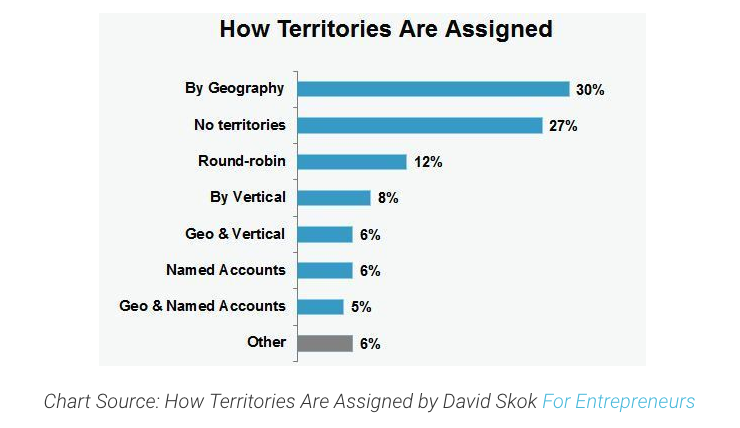
While most won’t want to admit this, the correlation between field sales and factors related to the salesperson’s effort and ability are likely less understood. Reps who don’t have the level of opportunity and success early on will easily get discouraged. You’ll quickly notice any positive momentum they had start to slip away, and with it goes their time of employment.
This is especially true if they see other people in the company experiencing a high level of success. Watching tenured salespeople who can milk a territory yet still find a way to be 100% over quota will only lead to frustration.
The easiest way to combat this issue head on is to assign accounts to reps who have low opportunity. Sales managers should implement a required activity level on opportunities and reassign the ones that aren’t met. This is assuming the sales rep not getting the same number of quality leads is actually putting in the effort needed to achieve their targets.
By giving more accounts to salespeople who have low opportunity, you give them a greater chance of generating sales and becoming successful. This could solve the retention problem you may be having.
#6 | Poor incentive and compensation structure
Every team will have top performers and underachievers. But where are the rest of your team members falling on the achievement scale? You want your top performers to make the most money, of course. But consider the message your compensation structure might send to others on your team.
If the highest earning sales people aren’t also some of the hardest working, it could be a result of unfair sales territory design. Your compensation structure may need to be restructured to match your sales process. Opportunities that are unevenly distributed skew the common metrics used to determine incentive-based pay.
When the numbers are impacted so heavily, it’s likely due to the territory more so than it is the sales rep. The reason being is that metrics tend to favor those with a greater number of large accounts in their pipeline. An alternative comp plan is based on a market share metric where those with fewer opportunities and accounts are more heavily favored.
If you want to accurately represent performance and ability within your organization, consider rethinking your sales territory design strategy to give reps more equitable opportunities with the right customer. Doing so will significantly increase the likelihood that metrics will paint a clearer picture based on sales skills, leading to properly incentivized pay.
The goal should be to build a culture that enforces pay for performance. Establishing a fair compensation plan is one of the most effective ways to motivate salespeople.
10 Step Process for Designing High-Performing Sales Territories
Due to our data-rich environment, you have access to more information than you need to address the problems you face. The best and easiest way for the majority of companies to start the sales territory design process is by focusing on geography, industry, and size.
For companies whose sales are highly relationship-based, randomly placed or sized, or target a very limited number of prospects, “named” accounts are a common alternative approach.
Key considerations in territory design:
- Is the workload equally divided between each member of the team?
- Does the territory design provide equal compensation opportunities?
- Is there a good mix of existing and new accounts per territory?
- Does the territory design allow easy travel time management?
Step 1 | Set clear sales goals
Accountability produces results. Think about what you want to accomplish and create S.M.A.R.T goals.
Most profitable (least risky): Evaluate which of your territories are most successful and double down on what’s already working.
Most growth: If you’re more focused on the long-term instead of the short-term, focus on territories that haven’t been worked yet. It’s likely to take longer to become profitable, but will generate greater growth over time.
Learning / new markets: To establish yourself in a new market segment or determine if it’s viable, send a canvasser into this territory to accomplish a specific task. This will help determine exactly what’s needed to succeed in that market.
Step 2 | Analyze capacity and performance
Once you’ve set clear sales goals, you need to look at historical performance data to determine your team’s sales capacity, i.e. the number of sales reps you need to accomplish your objectives.
To do this, ask yourself, “how many reps do I have on my team right now?” Then assess how many of them will realistically hit quota. Combine these figures with your organization’s average ramp time to understand how many sales reps you need to consistently hit your goals, month in and month out.
Step 3 | Identify your ICP
Next, identify your sales organization’s ideal customer profile, better known as an ICP. These are the people who have the highest likelihood of buying from your company and remaining loyal. They’re very important to your team’s success.
You need to know who these people are, what they like and dislike, the challenges they deal with on a regular basis, and where they’re located.
The question is, how do you find them? Start by analyzing your current customers. Which ones have been with you the longest and represent the most revenue for your company? Find out what these folks have in common with each other. Then use them as a template for your sales team’s ideal customer profile.
Note: SPOTIO’s Lead Machine will give you the data you need to identify new leads. With this tool, you’ll be able to search territories for qualified prospects, while filtering out bad fits using over 200 data attributes.
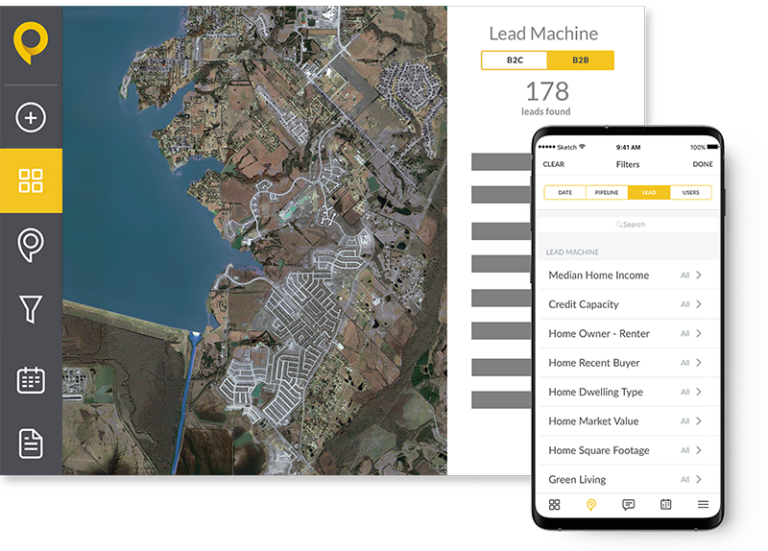
Step 4 | Use geographic and business data to design territories
At this point, you know what your sales team’s goals are, how many reps you need to accomplish said goals, and who your ideal customer is. Now it’s time to start designing territories that will help you accomplish your objectives.
There are different ways to create territories. For example, you can cut them based on geographical boundaries, segment boundaries, revenue boundaries, etc.
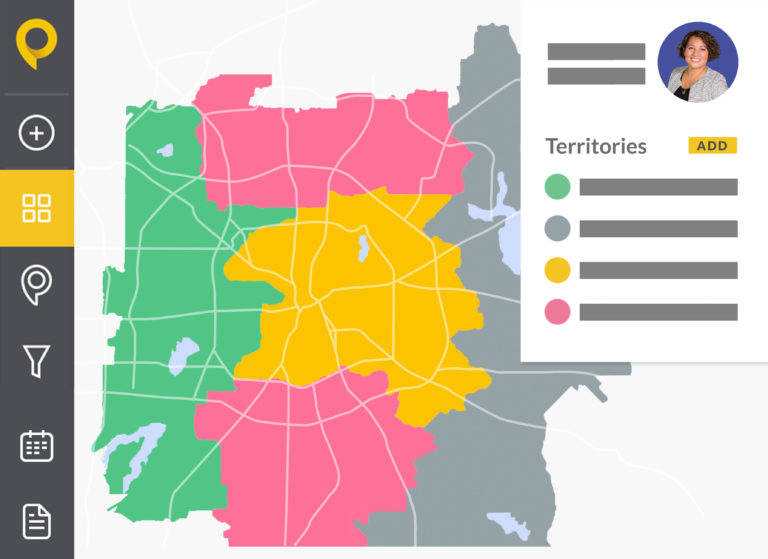
The method you use to determine territory boundaries will depend on your company and its customers, the products you sell, and the reps you employ. However you cut your territories, make sure the boundaries are equal and distinct.
Step 5 | Visualize new and existing leads
Now that your territories are cut, use a tool like SPOTIO to visualize the leads in each of them. When we say “visualize” we mean it literally.
SPOTIO allows users to visualize any data point, including ICPs, as pins on a digital map, which will help bring CRM data to life and ensure you don’t miss anything. Every data point pin can be color-coded as well to increase comprehension.

For instance, new leads can be assigned the color blue, missed opportunities can be yellow, current customers can be green, and ready-to-buy prospects can be red. Then, when you look at your digital map of customers, you’ll be able to quickly see where each one is located and how valuable they are to your company.
Step 6 | Segment territories by lead quality and quantity
You’ve visualized your leads in SPOTIO and color-coded them for easy reference. This will make it super simple to segment each of your territories by the quality and quantity of your leads, which is the next step in this process.
Take a minute to understand where your leads are and which of them represent the best opportunities for your sales team. That way you and your reps can increase sales productivity and focus your valuable time on the best leads.
Step 7 | Rank your talent
It’s important to know how each sales rep stacks up against the rest of your team. To accomplish this, create a scorecard and evaluate your sales reps to identify who your top, middle, and low level performers are.
- How much is their quota?
- Do they consistently achieve this number?
- How many current customers and prospects are in their funnel?
- How many viable prospects are located within their territory?
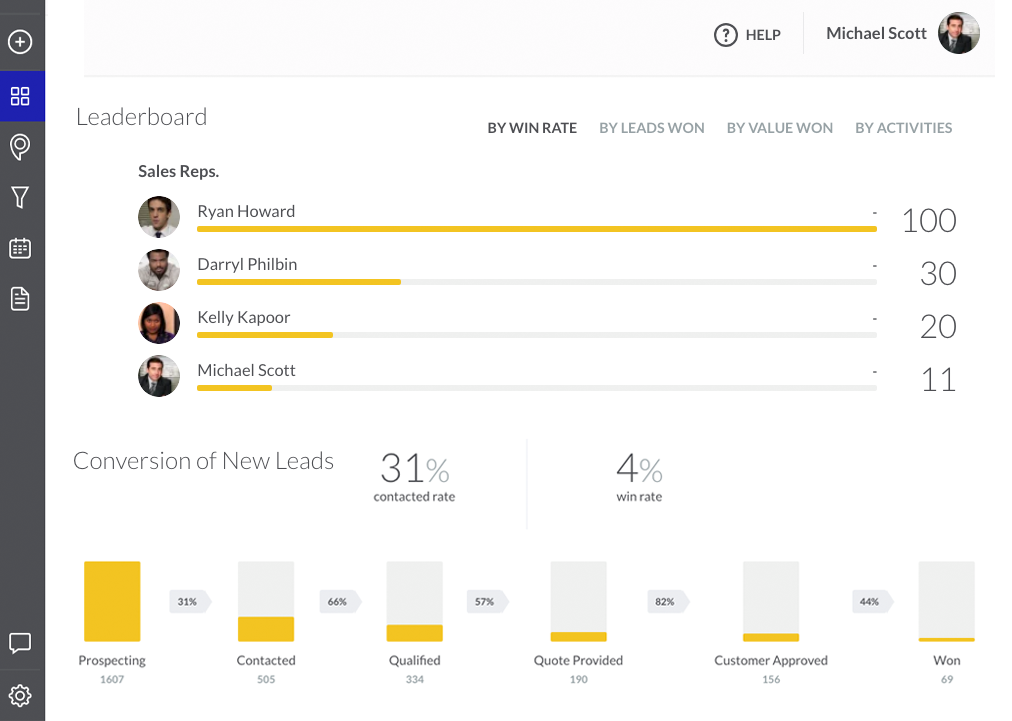
SPOTIO’s Leaderboard (above) is a great way to compare sales reps against each other. Doing so will give you actionable data you can use to coach your reps more effectively.
Once ranked, match the most fruitful territories to the higher ranked reps. However, things change throughout the year. Sales reps can exceed or fall short of expectations. So if adjustments need to be made, go ahead and do so.
Step 8 | Measure territory performance
Tracking performance against the KPI’s for each territory (think activities performed, the result of each activity, etc.) is extremely valuable because it gives managers key insights and data into sales reps performance.
With these metrics you can design more balanced territories and allocate them in a way that gives everyone the best chance to succeed.
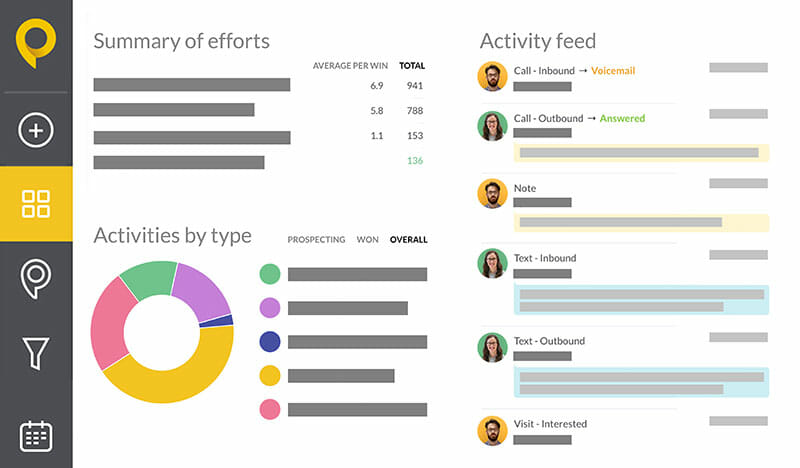
The importance of this data isn’t limited to understanding the needs of individual sales reps. Sales metrics are invaluable in understanding the success of every sales team within the company, and the entire sales department as a whole. They’ll also help you to spot trends and determine inefficiencies.
To accomplish this, I’d highly recommend implementing a sales enablement tool like SPOTIO to help you measure and see:
- Team performance in relation to your sales funnel
- Data from custom statuses and fields based on KPIs
- Graphs representing team performance, best time and day to knock, maps, etc.
- The number of attempts it takes to establish contacts, get leads and make sales
Step 9 | Analyze activity metrics
As mentioned above, it’s important to analyze your team’s activity metrics such as who they’ve contacted, how they contacted them, and the result of the interaction.
This is important because it will help you and your team improve sales productivity. You can easily look at the metrics and determine what’s working and what isn’t. You can then spend more time on the former and less on the latter.
The only way to fully optimize sales territories is to learn how your sales reps spend their time in each territory and adjust your sales process for peak efficiency.
Step 10 | Include Salespeople
Involving your sales reps is an important step in this process. Your team may surprise you with ideas you wouldn’t have come up with on your own.
It may take a little longer to create territories and implement your new plan. But your sales reps will feel valued if you involve them in the development process, which will help eliminate most of the typical frustrations associated with change.
The Benefits of Effective Sales Territory Design
Designing sales territories takes some effort, but is vital in establishing a solid foundation for your sales engine. The benefits you will notice are:
- More time selling and less time driving from prospect to prospect
- Better sales force morale due to the more even distribution of workload and sales potential
- Improved customer coverage, resulting in more sales
- A better knowledge of which prospects you should focus on
- Higher revenue potential
If your sales territory design is on-point, the workload of sales reps declines and they become more efficient and thus, more successful. And a successful employee is a happy employee, which means your department’s turnover rate will improve, too.
Design High-Performing Territories With SPOTIO
Sales territory design is essential to the success of your sales team. Without it, your reps will overlap, grow frustrated, and maybe even quit.
The good news is all of these efficiencies are perfectly avoidable. All you have to do is implement a sales territory management plan. To do so, follow the 10-step process we outlined above and (this is important!) stick to it.
The easiest way to design high-performing territories is with SPOTIO. Our industry-leading software is easy to use and powerful, enabling our users to quickly cut territories based on geography, customer type, or anything else.
Once a territory is cut, SPOTIO helps you manage it by allowing you to visualize leads, segment them as you wish, and track the sales activities that happen inside them. In other words, it’s the complete sales territory design tool you need.
Request a free demo of SPOTIO today to see if it’s the right solution for your team.
______
SPOTIO is the #1 field sales engagement and performance management software that will increase revenue, maximize profitability, and boost sales productivity.
Want to see a product demonstration? Click here to see how SPOTIO can take your sales game to the next level.


